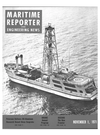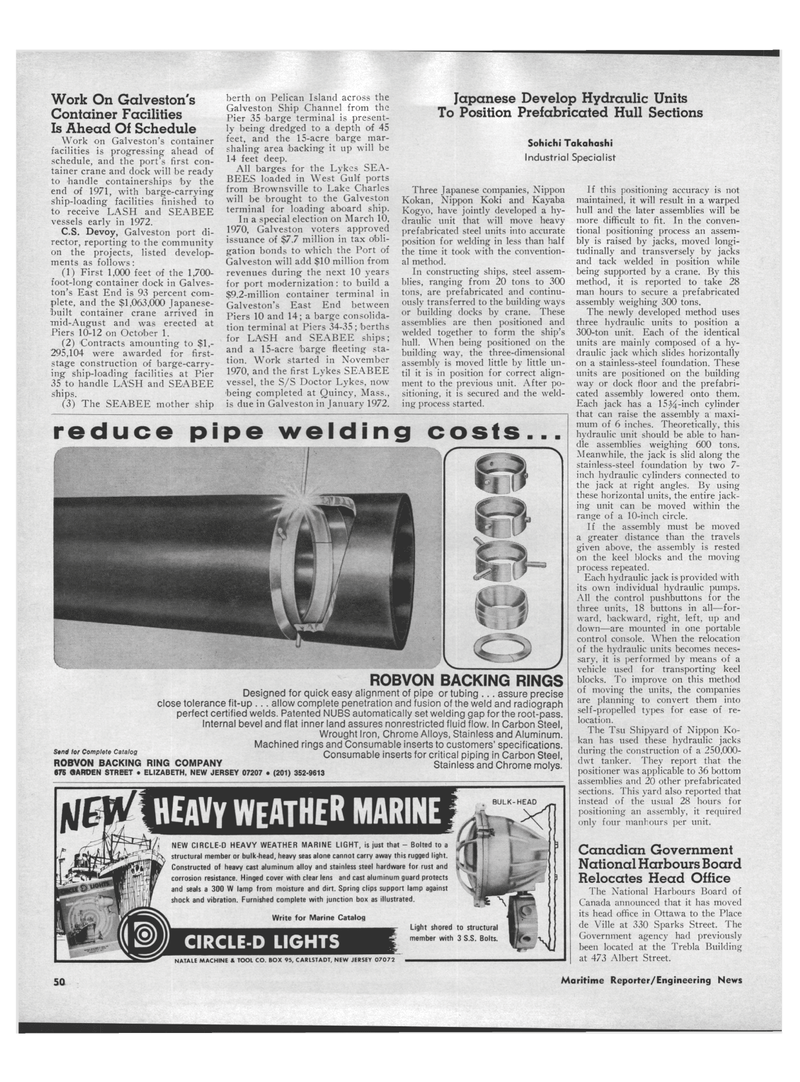
Page 50: of Maritime Reporter Magazine (November 1971)
Read this page in Pdf, Flash or Html5 edition of November 1971 Maritime Reporter Magazine
Japanese Develop Hydraulic Units
To Position Prefabricated Hull Sections
Sohichi Takahashi
Industrial Specialist
Work On Galveston's
Container Facilities
Is Ahead Of Schedule
Work on Galveston's container facilities is progressing ahead of schedule, and the port's first con- tainer crane and dock will be ready to handle containerships by the end of 1971, with barge-carrying ship-loading facilities finished to to receive LASH and SEABEE vessels early in 1972.
C.S. Devoy, Galveston port di- rector, reporting to the community on the projects, listed develop- ments as follows: (1) First 1,000 feet of the 1,700- foot-long container dock in Galves- ton's East End is 93 percent com- plete, and the $1,063,000 Japanese- built container crane arrived in mid-August and was erected at
Piers 10-12 on October 1. (2) 'Contracts amounting to $1,- 295,104 were awarded for first- stage construction of barge-carry- ing ship-loading facilities at Pier 35 to handle LASH and SEABEE ships. (3) The SEABEE mother ship berth on Pelican Island across the
Galveston Ship Channel from the
Pier 35 barge terminal is present- ly being dredged to a depth of 45 feet, and the 15-acre barge mar- shaling area backing it up will be 14 feet deep.
All barges for the Lykes SEA-
BEES loaded in West Gulf ports from Brownsville to Lake Charles will be brought to the Galveston terminal for loading aboard ship.
In a special election on March 10, 1970, Galveston voters approved issuance of $7.7 million in tax obli- gation bonds to which the Port of
Galveston will add $10 million from revenues during the next 10 years for port modernization: to build a $9.2-million container terminal in
Galveston's East End between
Piers 10 and 14; a barge consolida- tion terminal at Piers 34-35 ; berths for LASH and SEABEE ships; and a 15-acre barge fleeting sta- tion. Work started in November 1970, and the first Lykes SEABEE vessel, the S/S Doctor Lykes, now being completed at Quincy, Mass., is due in Galveston in January 1972.
Three Japanese companies, Nippon
Kokan, Nippon Koki and Kayaba
Kogyo, have jointly developed a hy- draulic unit that will move heavy prefabricated steel units into accurate position for welding in less than half the time it took with the convention- al method.
In constructing ships, steel assem- blies, ranging from 20 tons to 300 tons, are prefabricated and continu- ously transferred to the building ways or building docks by crane. These assemblies are then positioned and welded together to form the ship's hull. When being positioned on the building way, the three-dimensional assembly is moved little by little un- til it is in position for correct align- ment to the previous unit. After po- sitioning, it is secured and the weld- ing process started.
If this positioning accuracy is not maintained, it will result in a warped hull and the later assemblies will be more difficult to fit. In the conven- tional positioning process an assem- bly is raised by jacks, moved longi- tudinally and transversely by jacks and tack welded in position while being supported by a crane. By this method, it is reported to take 28 man hours to secure a prefabricated assembly weighing 300 tons.
The newly developed method uses three hydraulic units to position a 300-ton unit. Each of the identical units are mainly composed of a hy- draulic jack which slides horizontally on a stainless-steel foundation. These units are positioned on the building way or dock floor and the prefabri- cated assembly lowered onto them.
Each jack has a 15^4-inch cylinder that can raise the assembly a maxi- mum of 6 inches. Theoretically, this hydraulic unit should be able to han- dle assemblies weighing 600 tons.
Meanwhile, the jack is slid along the stainless-steel foundation by two 7- inch hydraulic cylinders connected to the jack at right angles. By using these horizontal units, the entire jack- ing unit can be moved within the range of a 10-inch circle.
If the assembly must be moved a greater distance than the travels given above, the assembly is rested on the keel blocks and the moving process repeated.
Each hydraulic jack is provided with its own individual hydraulic pumps.
All the control pushbuttons for the three units, 18 buttons in all—for- ward. backward, right, left, up and down—are mounted in one portable control console. When the relocation of the hydraulic units becomes neces- sary, it is performed by means of a vehicle used for transporting keel blocks. To improve on this method of moving the units, the companies are planning to convert them into self-propelled types for ease of re- location.
The Tsu Shipyard of Nippon Ko- kan has used these hydraulic jacks during the construction of a 250,000- dwt tanker. They report that the positioner was applicable to 36 bottom assemblies and 20 other prefabricated sections. This yard also reported that instead of the usual 28 hours for positioning an assembly, it required only four manhours per unit.
Canadian Government
National Harbours Board
Relocates Head Office
The National Harbours Board of
Canada announced that it has moved its head office in Ottawa to the Place de Ville at 330 Sparks Street. The
Government agency had previously been located at the Trebla Building at 473 Albert Street. reduce pipe welding costs
Send lor Complete Catalog
ROBVON BACKING 67S OAROEN STREET
ROBVON BACKING RINGS
Designed for quick easy alignment of pipe or tubing ... assure precise close tolerance fit-up ... allow complete penetration and fusion of the weld and radiograph perfect certified welds. Patented NUBS automatically set welding gap for the root-pass.
Internal bevel and flat inner land assures nonrestricted fluid flow. In Carbon Steel,
Wrought Iron, Chrome Alloys, Stainless and Aluminum.
Machined rings and Consumable inserts to customers' specifications.
Consumable inserts for critical piping in Carbon Steel,
RING COMPANY Stainless and Chrome molys. • ELIZABETH, NEW JERSEY 07207 • (201) 352-9613
NEW CIRCLE D HEAVY WEATHER MARINE LIGHT, Is just that - Bolted to a structural member or bulk-head, heavy seas alone cannot carry away this rugged light.
Constructed of heavy cast aluminum alloy and stainless steel hardware for rust and corrosion resistance. Hinged cover with clear lens and cast aluminum guard protects and seals a 300 W lamp from moisture and dirt. Spring clips support lamp against shock and vibration. Furnished complete with junction box as illustrated.
Write for Marine Catalog
CIRCLE D LIGHTS
NATALE MACHINE & TOOL CO. BOX 95, CARISTADT, NEW JERSEY 07072
Light shored to structural member with 3 S.S. Bolts. 50 Maritime Reporter/Engineering News

 49
49

 51
51
